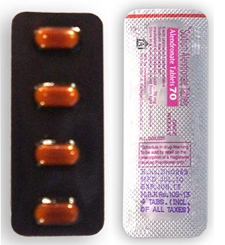|
Alendronate comes in both tablet
and liquid solution forms. Tablets are taken with a glass of water
in the morning, before breakfast. The manufacturer also recommends
drinking some water when the drug is taken in solution form. You
aren't supposed to eat within 30 minutes of taking the drug.
It is available only by presecription and
should be taken only under a doctor's care. You should not take
alendronate while pregnant.
Doctors set the dosage level for
each patient. Typically osteoporosis patients take 5 to 10 mg/day.
5 mg/day is often used to prevent osteoporosis. Paget's disease
patients take a much higher doase - 40 mg/day.
Alkaline phosphatase is an
enzyme that can be used as a biomarker in alendronate treatment.
Along with blood levels of calcium and phosphorus, it is
periodically measured in patients. Bone density is often measured
to see if the drug is working as intended.
Alendronate is not approved for
pregnant women, and because the drug stays in the body for years,
it is not often used if there is a change the patient may get
pregnant in the future.
Because of
the drug's impace on the bone system, patients often are advised
to take calcium and Vitamin D supplements. Women over age 50
should consume 1200-1500 mg/day of elemental calcium and 800-1000
int. units/day of vitamin D.
It is commonly thought that osteoporosis
results only from a reduction in bone mass (i.e., from bone loss).
However, the condition can also result from never having obtained
adequate bone mass during a person’s adolescent and young adult
years. Therefore, the risk factors for osteoporosis begin early in
life and include genetic, clinical, medical, behavioral, and
dietary vulnerabilities. Additionally, risk factors that occur in
combinations augment the chance of osteoporosis in an additive
fashion. In other words, someone with two risk factors has a
higher risk than someone with just one risk factor.
Genetic risk factors include:
Caucasian or Asian ethnicity, family history of fractures, and
family history of osteoporosis. African Americans have the lowest
occurrence of osteoporosis of all ethnic populations. Clinical
risk factors for osteoporosis include: female gender, older age,
estrogen deficiency, and low weight or small body size. Medical
risk factors include: anorexia nervosa, hypogonadism,
gastrointestinal disorders, malabsorption syndromes, hematologic
disorders, and use of certain medications (e.g., glucocorticoids,
diuretics, anticonvulsants, immunosuppressive medications, asthma
medications, and some antibiotics). Behavioral and dietary risk
factors include: excessive or too little exercise, smoking, high
caffeine intake, consuming too much alcohol, and calcium and
Vitamin D deficiencies. |




